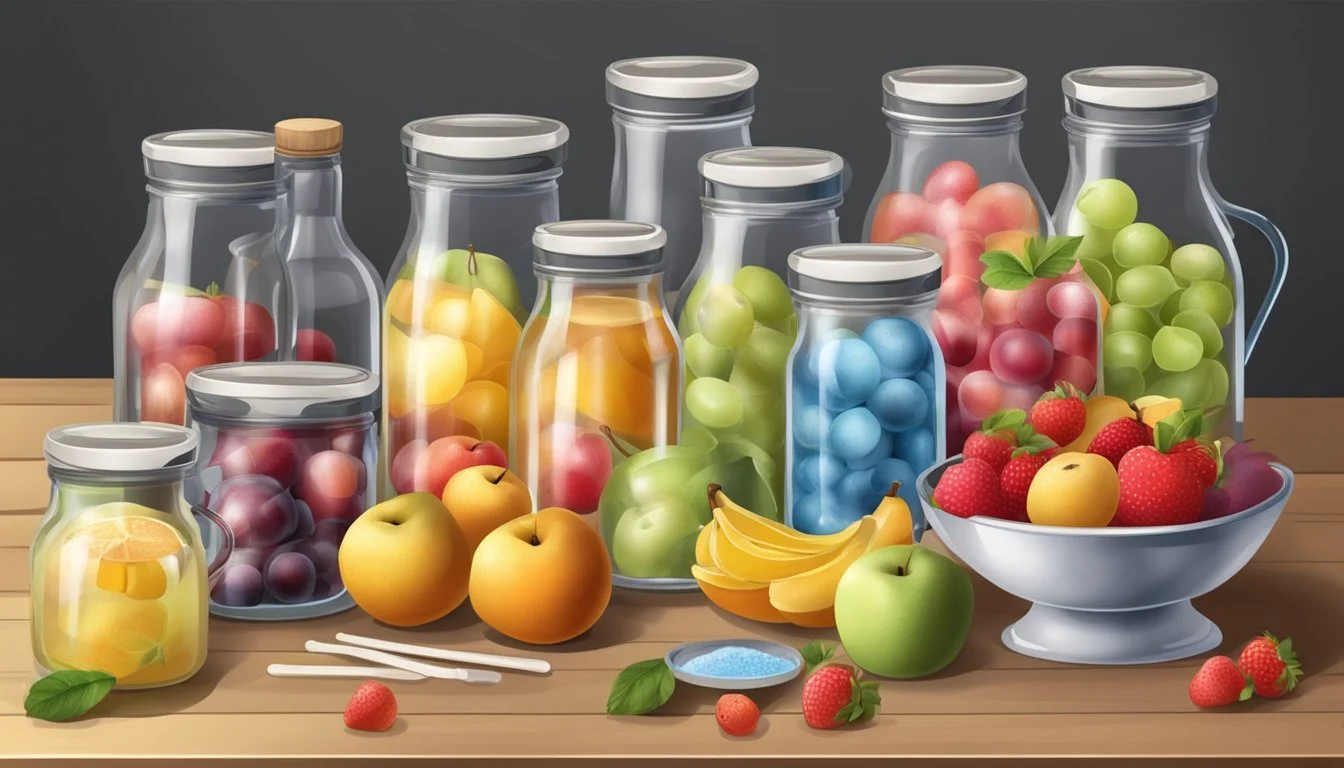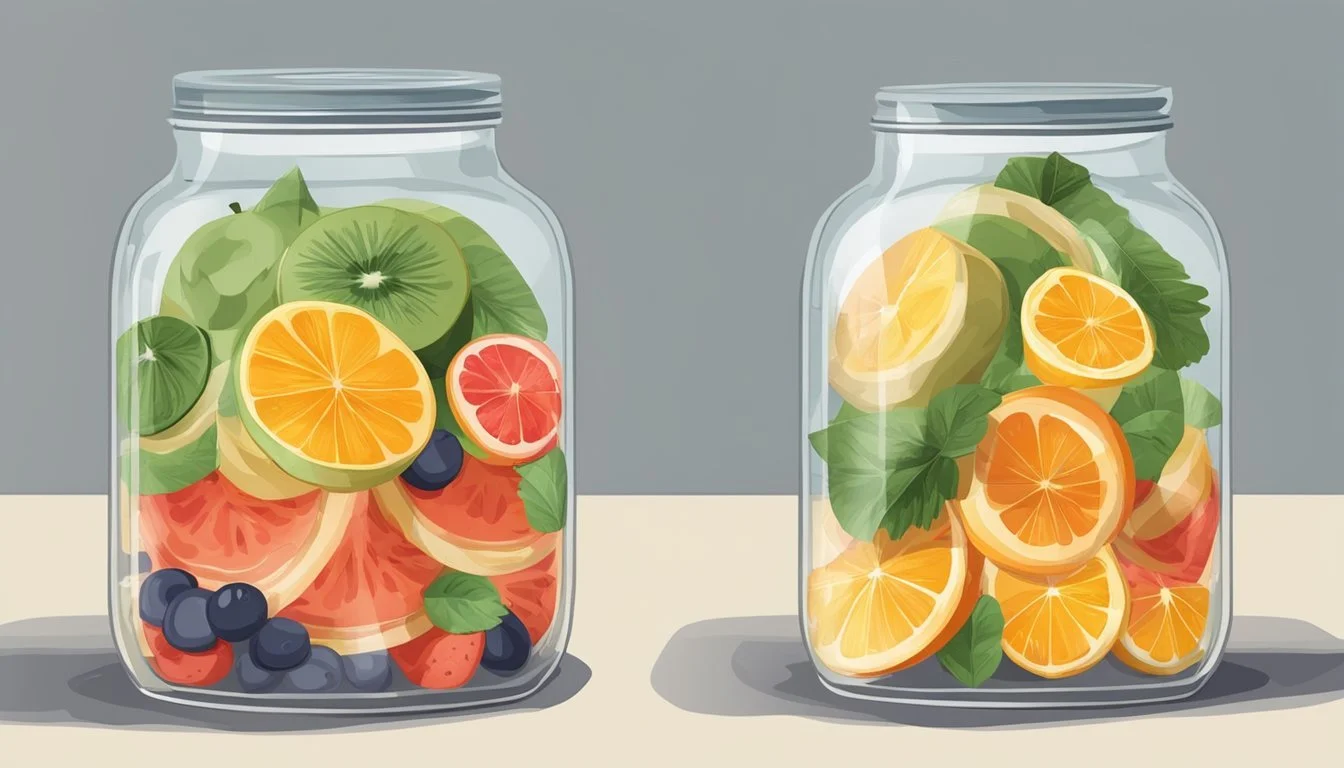How to Ferment Fruits
A Step-by-Step Guide for Homemade Fermentation
Fermentation is an ancient method of preserving food that enhances the flavor and nutritional value of fresh produce like fruit (What wine goes well with fruit?). This process involves a natural occurrence where microorganisms, typically yeast and bacteria, convert sugars into alcohol and acids. When applied to fruit, the result is a product rich in probiotics that not only extends the shelf life but also can contribute to gut health.
Fermenting fruit requires precision and care. The key to success lies in creating an environment conducive to beneficial bacteria and yeast, which in turn transform the fruit's natural sugars. During this transformative phase, fruits (What wine goes well with fruits?) develop a unique, tangy flavor profile, which is highly sought after not just for its taste but also for its health benefits.
To achieve quality fermented fruit, enthusiasts must monitor sugar levels, temperature, and time, as these factors are instrumental in steering the fermentation process. By ensuring the right conditions, fermented fruits can be a delightful addition to one's diet, offering a complex flavor spectrum while serving as a homemade source of probiotics.
Understanding Fermentation
Fermentation is the transformative process where microorganisms like yeast and bacteria convert sugars into alcohol, acids, and gases. It is a cherished technique that enhances food preservation and flavors.
Basics of Fruit Fermentation
Fruit fermentation is a controlled microbial process, primarily involving yeast and lactic acid bacteria. These microorganisms feed on the sugars present in the fruit, producing alcohol and lactic acid as byproducts. This method not only preserves the fruit but also creates complex flavors. Yeast typically leads to the formation of alcohol, while lactic acid bacteria are the primary agents in producing tangy flavors and preserving the fruit.
Essential Conditions for Fruit Fermentation:
Anaerobic Environment: Limited oxygen to prevent spoilage.
Temperature: Warm enough to encourage fermentation, usually between 60°F and 75°F.
pH: Slightly acidic conditions favor good bacteria.
Fermentation vs. Spoilage
Fermentation and spoilage may seem similar, as both are outcomes of bacterial activity. However, they are starkly different. Fermentation is a deliberate process employing good bacteria like Lactobacillus, which produces desirable changes in food. These bacteria outcompete bad bacteria that could cause rotting and spoilage. Controlling factors such as salt concentration, temperature, and sanitation helps ensure that fermentation occurs instead of spoilage.
Key Differences:
Desired Microbes: Fermentation utilizes specific strains of bacteria and yeast.
Control: Fermentation is a controlled process with steps to inhibit spoilage.
End Products: Fermentation results in palatable acids and alcohols, while spoilage often leads to off-flavors and harmful substances.
The Role of Sugar in Fermentation
Sugars are the cornerstone of fruit fermentation. The process is initiated when yeast and lactic acid bacteria metabolize the natural sugars in fruit to produce alcohol and lactic acid. The type and quantity of sugar will influence the speed and outcome of the fermentation. Not all sugars are equal; different fruits will ferment at varied rates, depending on their sugar content.
Types of Sugars in Fruits:
Glucose: A simple sugar readily fermented.
Fructose: Another simple sugar, common in fruits, that ferments easily.
Sucrose: A complex sugar that yeast must break down into simpler sugars before fermentation.
The right balance of sugar ensures that the fruit ferments properly without supporting the growth of unwanted microorganisms.
Preparing the Fruits
In the preparation of fruits for fermentation, careful selection, cleaning, and preparation are essential steps. These initial stages set the foundation for successful fermentation, ensuring safety and optimal flavor development.
Choosing the Right Fruits
One seeks out fresh fruit that is ripe but not overripe. Ideal candidates for fermentation are fruits free of blemishes and bruises, as damaged areas can lead to spoilage and mold growth. Some fruits, like grapes or plums, have naturally occurring yeast on their skins, which can be beneficial for the fermentation process.
Fresh Fruit: Must be ripe and free of blemishes
Ripe Fruit: At the peak of flavor, not overripe
Washing and Prepping
Fruit should be washed thoroughly to remove any dirt, pesticides, or unwanted microorganisms. However, washing must be gentle to avoid bruising. After washing, fruits must be dried carefully with a clean towel to remove excess moisture that could dilute the fermentation medium or introduce unwanted pathogens.
Gently wash the fruit to remove contaminants.
Pat dry with a clean cloth.
Cutting and Bruising Considerations
Fruits are often cut into smaller pieces to increase surface area and expedite the fermentation process. However, one must find a balance to avoid excessive bruising, which could promote the growth of harmful bacteria. Larger fruits like apples or pears should be cored and chopped, while smaller ones like berries can be left whole if they are punctured to release the juices.
Small fruits: Puncture to release juice.
Large fruits: Core and chop to increase surface area.
Note: While preparing the fruits, ensure that hands and surfaces are clean to prevent cross-contamination.
Fermentation Ingredients and Additives
In successful fruit fermentation, the choice of ingredients and additives plays a crucial role. Certain substances not only ensure the preservation of the fruit but also enhance the flavors and nutritional benefits of the final product.
Using Salt and Sugar
Salt: A critical ingredient, often at a ratio of around 2% of the weight of the fruit, creates an environment that favors beneficial bacteria and prevents the growth of harmful ones. It is preferable to use non-iodized salt to avoid any chemical reactions that might affect the fermentation process.
Sugar: While fruits naturally contain sugar, sometimes additional sugar is added to feed the yeast and bacteria. Honey can be used as an alternative to processed sugar, adding distinct flavor notes.
Starter Cultures and Probiotics
Starter Culture: This may include a lactic acid bacteria source which helps to kickstart fermentation. It ensures a more predictable outcome by providing an initial dose of the necessary microbes.
Probiotics: Probiotics, synonymous with live cultures, can come from commercially prepared packets or from a previous batch of fermented product. They are essential for transforming the fruit into a tangy fermented delight.
Other Flavorings and Considerations
Spices and Vinegar: Adding spices can imbue the ferment with complex tastes, while a splash of vinegar might aid in the acidity and preservation.
Considerations: One must ensure that all additions are free of antimicrobial properties that could inhibit fermentation. Ensuring the fruit is submerged, either in its own juice or a brine, and kept away from air is crucial for a successful ferment.
Equipment Essentials
In fermenting fruits, the right equipment ensures both the safety and quality of the final product. The following tools are fundamental for any fruit fermentation project.
Selecting the Correct Container
When fermenting fruits, the container is crucial. Mason jars are a popular choice for their availability and convenient sizes. A person should opt for glass jars to avoid reactions with acidic fruits fermenting within. Additionally, the use of wide-mouth mason jars is advised for easy packing and removal of ingredients.
Weights and Sealing Methods
To submerge fruit under the brine and prevent exposure to air, a fermentation weight is necessary. These can be purchased or improvised with a clean, boiled rock or a smaller glass jar. For sealing, one may use a traditional water seal, which allows gases to escape while preventing outside air from entering, or a mason jar with an airlock. Securing a tight seal is important to prevent contaminants.
Monitoring Tools
Accurate results require monitoring. A kitchen scale can be invaluable for measuring the right proportion of ingredients. During fermentation, the temperature must be kept consistent, ideally between 60-75°F (15-24°C), to achieve desired fermentation results. One can use thermometers to manage this aspect. Regular visual checks for signs of mold or yeast development are crucial and should be part of one's routine.
The Fermentation Process
In fermenting fruits, one crafts an anaerobic environment for beneficial bacteria to thrive, converting sugars into alcohol and carbon dioxide. Precise control of elements such as temperature and air exposure is pivotal to achieve desired sensory qualities like aroma and consistency without unwanted mold or kahm yeast growth.
Creating the Right Environment
To ensure a successful fermentation, one must provide conditions conducive to microbial activity and flavor development. Room temperature (around 68–72°F or 20–22°C) typically strikes an ideal balance, accelerating fermentation without risking the growth of harmful bacteria. One begins by preparing a water-based brine; this salty solution deters undesirable organisms while keeping the fruit submerged, limiting air exposure. A jar with a loose lid is often used, allowing for bubbles of carbon dioxide to escape while maintaining an adequate barrier against contaminants.
The Stages of Fermentation
The fermentation process unfolds over several stages:
Initialization: Fruits are submerged in brine or their own juices. Beneficial microorganisms begin to metabolize sugars, creating bubbles and a slight change in aroma.
Active Fermentation: As the bacteria produce more carbon dioxide and ethanol, the environment becomes tangibly more acidic. Bubbles will be noticeable at this stage and sometimes a frothy layer appears on the surface.
Preservation: Over time, the ferment becomes inhospitable to pathogens due to the acidity and alcohol content, preserving the fruit. The frequency of bubbles decreases, indicating that fermentation is slowing down.
Monitoring temperature throughout these stages is critical, as fluctuations can affect both the fermentation rate and the quality of the final product.
Handling Mold and Kahm Yeast
Fruit ferments may occasionally develop white films or molds on the surface, but not all are cause for concern.
Kahm yeast: A thin, white layer that may develop on the surface but is mostly harmless. It can impart off-flavors, so it should be removed when spotted.
Mold: Fuzzy and typically colorful colonies that indicate contamination. Fruit ferments showing mold should be discarded to avoid health risks.
Regular visual checks are essential, as is maintaining a proper brine level to protect the fruit from air which might introduce new contaminants. If one sees mold or detects an offputting aroma, it is advised to discard the batch and start anew, ensuring that all equipment is properly sterilized.
Recipes and Flavor Combinations
Fruit fermentation unlocks new flavor profiles and extends the shelf life of fresh produce. This section explores various recipes from classic to innovative, and highlights ways to incorporate these tangy treats into meals.
Classic Fruit Fermentation Recipes
Raspberry Shrub: A traditional recipe combining raspberries with hibiscus and rose hips, creating a tangy, floral concoction.
Ingredients: Fresh raspberries, dried hibiscus flowers, rose hips, sugar, vinegar.
Method: Macerate the raspberries with sugar, then add vinegar and infuse with hibiscus and rose hips.
Preserved Lemons: A staple in Moroccan cuisine, preserved lemons are salty, tart, and aromatic.
Ingredients: Fresh lemons, coarse salt.
Method: Quarter the lemons, cover with salt, and seal in a jar to ferment.
Innovative Fermenting Ideas
Tepache de Piña: A refreshing fermented beverage made from the peel and core of pineapples with a touch of spice.
Ingredients: Pineapple peel, brown sugar, cinnamon, cloves.
Method: Combine ingredients with water in a vessel; ferment for 3 days until bubbly.
Peach and Basil Delight: A unique blend that combines sweet peaches with aromatic basil for a surprising twist.
Ingredients: Fresh peaches, fresh basil leaves, honey, salt.
Method: Weigh ingredients, add 2% of their total weight in salt, and ferment in a suitable vessel.
Using Fermented Fruits in Meals
Salsa or Chutney: Incorporate fermented fruits like tomatoes or mangoes to add zesty flavors to these condiments.
Salsa: Mix fermented tomatoes with onions, cilantro, and lime juice.
Chutney: Combine fermented mangoes with ginger, garlic, and spices.
Smoothie Enhancement: Adding fermented fruits to smoothies can introduce probiotics and an intriguing depth of taste.
Preparation: Blend fermented berries with yogurt and a touch of honey for a gut-friendly and flavorful smoothie.
Aftercare and Storage
Proper aftercare is crucial for maintaining the quality of fermented fruit, and employing appropriate storage techniques ensures both safety and longevity of the product.
Caring for Fermented Fruit
Once fruit has been fermented, it continues to change as it ages. The fruit should be kept in a cool, dark place during this maturation process to slow down fermentation and prevent spoilage. Temperature plays a vital role; fermented fruit ideally should be stored at a temperature that is consistent and cool, generally between 55°F and 65°F (13°C and 18°C). It's essential to monitor for signs of mold or off smells, which indicate contamination or spoilage. If fruit needs to be stored beyond the initial fermentation period, transferring it to a refrigerator can significantly slow down fermentation and preserve the fruit's flavor.
Bottling and Storage Techniques
When it's time to store fermented fruit for the long term, choosing the right containers is key. Glass bottles or jars with air-tight seals are recommended to prevent oxygen from spoiling the fruit. To bottle:
Ensure that bottles or jars are sterilized to remove any existing bacteria.
Fill bottles, leaving about an inch of headspace to accommodate any expansion.
Seal the containers tightly to prevent air exposure.
Fermented fruit should be stored in the refrigerator to prolong shelf life and maintain quality. When stored properly, fermented fruit can last for several months. However, if the ferments are intended for long-term storage, it is often recommended to use methods such as canning to seal the freshness and extend the shelf life even further. Regular assessment of the fermented product is recommended to ensure it remains safe and enjoyable to consume.
Health Benefits and Uses
Fermented fruits are treasures of health boosting properties, chiefly from their probiotics and enhanced nutritional value. They are versatile and can be seamlessly integrated into daily diets for beneficial effects.
Probiotics and Gut Health
Probiotics, the beneficial bacteria in fermented fruits, play a crucial role in maintaining a balanced gut microbiome. The process of fermentation naturally cultivates probiotic strains that aid in digestion and boost gut health. Examples of these strains include Lactobacillus and Bifidobacterium. Regular consumption of fermented fruits can help in alleviating digestive issues and enhancing the immune system.
Nutritional Value of Fermented Fruits
The fermentation of fruits can increase the bioavailability of nutrients, meaning the body can absorb them more efficiently. Fermented fruits typically contain a diverse array of vitamins and minerals, including Vitamin C, B vitamins, and potassium. The fermentation process can also produce additional beneficial enzymes and amino acids.
Vitamins: Enhanced levels post-fermentation.
Minerals: Greater bioavailability for the body's use.
Enzymes: Assist in the breakdown and absorption of nutrients.
Incorporating Fermented Fruits into Diets
Incorporating fermented fruits into diets can be both creative and beneficial. They can be added to breakfast bowls, used as a tangy ingredient in salads, or blended into smoothies for an extra health kick.
Breakfast: Top yogurt or oatmeal with fermented berries.
Salads: Add fermented apples for a sweet and sour crunch.
Smoothies: Blend fermented pineapple or mango for a tropical twist.
By introducing these probiotic-rich foods into one's diet, they not only add a unique flavor profile but also contribute to a healthier gut and overall wellbeing.






